
As I was researching this topic, I noticed that many websites got the meaning and process of identifying primary keywords totally wrong.
But don’t worry, I’m here to set the record straight and provide you with a clear and accurate understanding of what primary keywords are, how to identify them, and the best practices.
So, if you want to improve your search engine optimization and drive more qualified traffic to your website, keep reading to learn the truth about primary keywords.
What are Primary Keywords?

Primary keywords are the main keywords that people use to search for a particular topic or piece of information. They are the most relevant and specific terms related to the topic and are often more popular or in demand than other variations or synonyms.
These keywords are the ones that you will focus on optimizing for with a dedicated page on your website and it will form the content. The goal is to have this optimized page rank highly in the search engine results pages (SERPs) for the primary keyword.
Therefore, primary keywords are the most important keywords for SEO because they are the ones that the search engines use to understand the content of the page and to determine how relevant it is to a particular search query.
So, it is important when you do keyword research to choose primary keywords carefully and you should be only targeting keywords that are related to your niche, industry, and/or business.
Additionally, primary keywords are not only head keywords or body keywords but ANY keywords that can be targeted with a web page including head, body, and long-tail keywords. Primary keywords are not those keywords that you cannot target because search engines show different primary keywords.

How to Identify Primary Keywords?
Identifying the primary keyword is a key step in keyword analysis in order to find the main version of the keyword with the highest organic traffic potential that you should target with your web page.
Like this, you always ensure you are targeting the right SEO keyword, minimize any keyword cannibalization mistakes, and can ensure you can optimize your content and on-page SEO properly to attract the highest amount of organic traffic which can lead to higher conversions and more success for your business and maximize your SEO efforts.
With that being said, here is the step-by-step process on how to identify primary keywords:
Step #1: Analyze the SERPs to Validate the Keyword
The first step is to analyze your keyword in SERPs to ensure that the keyword in fact is a primary keyword and not secondary.
Because in many situations, you can find a keyword that cannot be targeted because it’s just a different variant of another primary keyword.
So, to find out, whether your target keyword is the main primary keyword or only a synonym variant of another primary keyword you need to analyze the SERPs. So let me give you a few examples:
Example #1: Keyword “seo strategies”
To analyze the keyword in SERPs I will be using the SEO tool SE Ranking so I can analyze the keyword without any personalization and select my target country.

Then I will go to the “Organic Results” report to see what pages and keywords are actually ranking for this keyword.
Here I will want to look at the titles and the URL of the ranking pages to see what primary keyword they target, so I can see whether the primary keyword matches the analyzed keyword “seo strategies”.

However, in this example, I can see that my analyzed keyword doesn’t match the SERPs and that the primary keywords here are “seo strategy”.

And the second primary keyword is “seo techniques”.
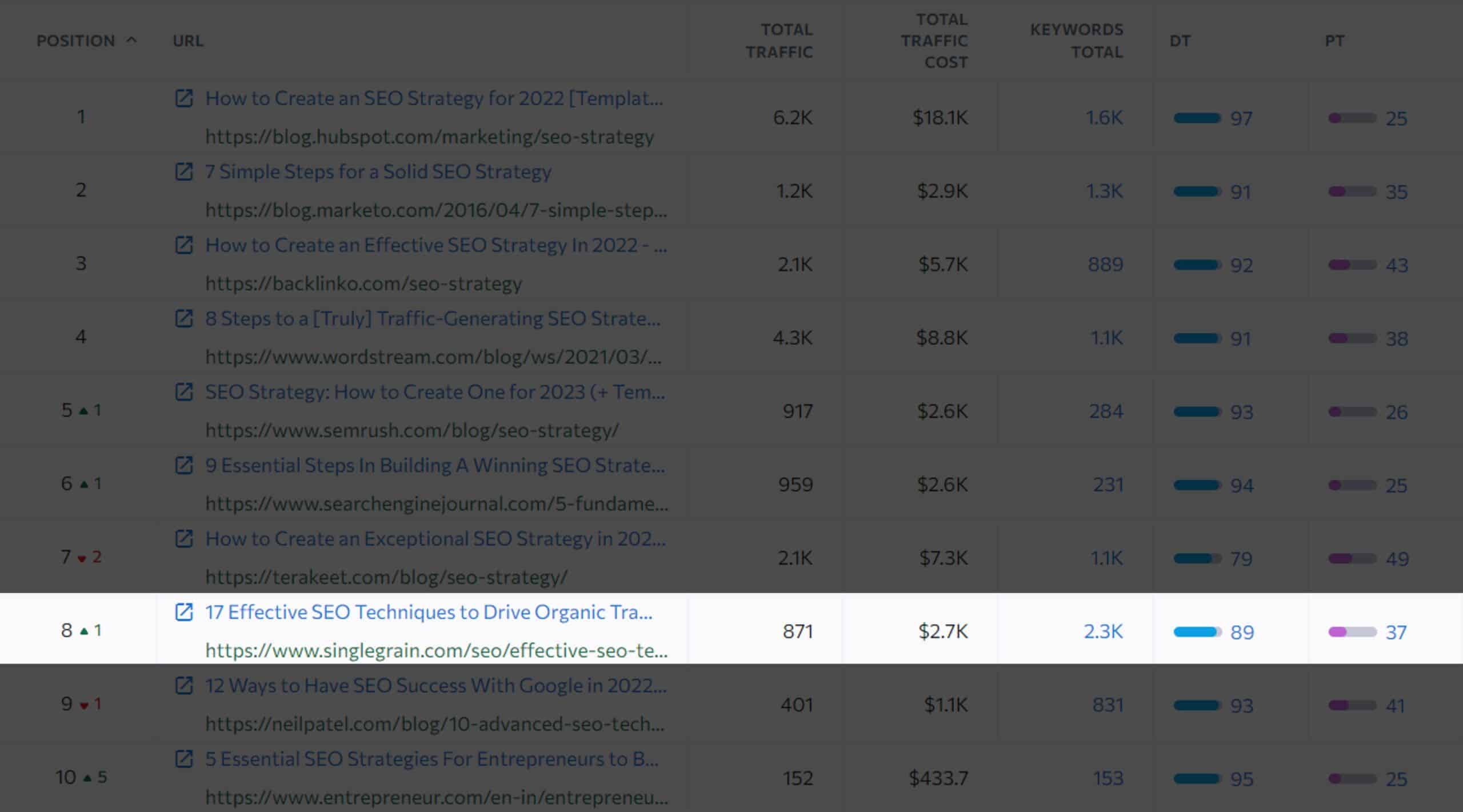
This means, that the keyword “seo strategies” is not primary, and to rank for the keyword, I would have to target the other primary keywords “seo techniques” and “seo strategy” and use the keyword “seo strategies” as a secondary keyword for these articles.
Therefore, I will not waste my time on this keyword and note the other two keywords in my keyword list to analyze them later.
Example #2: Keyword “landscaping designs for backyard”
So, let’s again check the SERPs for this keyword using SE Ranking Keyword Research tool. Again, I select my target location.
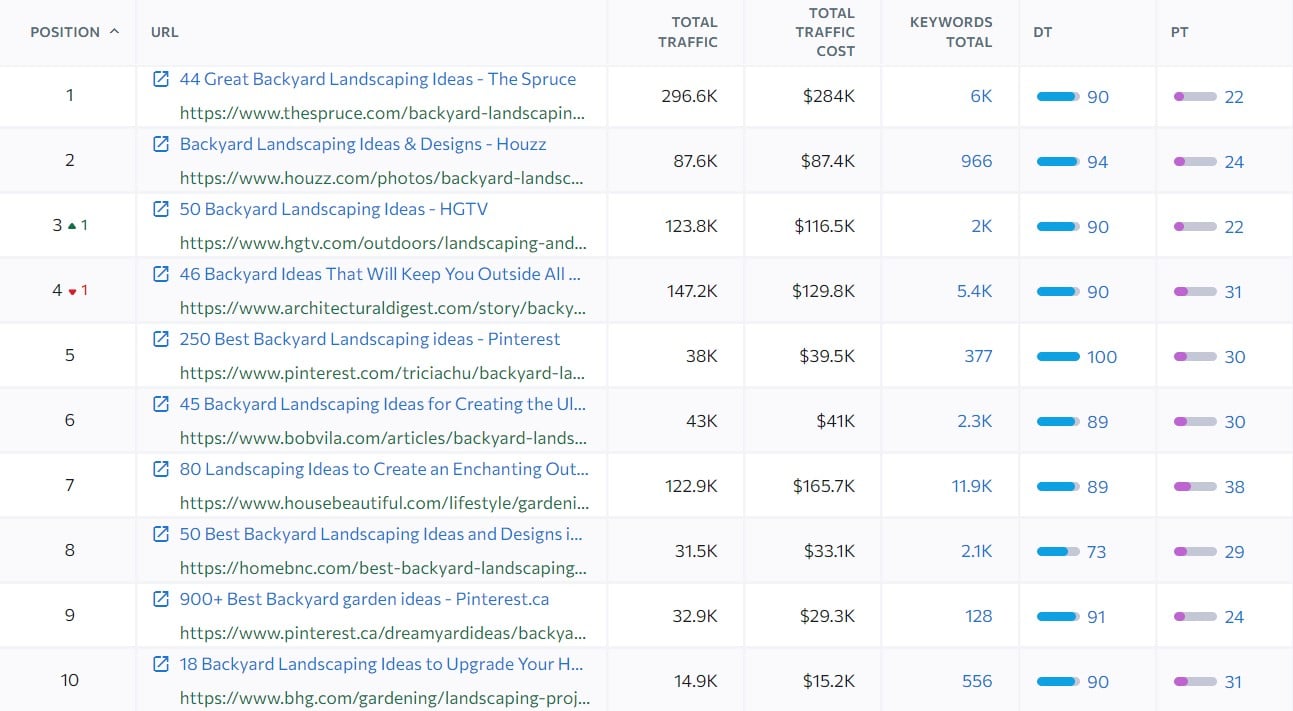
Based on this I can clearly see that my keyword is not the primary keyword, but only a different variant for the primary keyword “backyard landscaping ideas” or “backyard ideas”.

However, later on, I will want to compare the keywords research volume for my keyword “landscaping designs for backyard” with the keyword “backyard landscaping ideas” to find out which variety has higher search demand.
BTW if you are into the landscaping business check out my guide for SEO landscaping.
Example #3: Keyword “how to stop a nosebleed”
Again, let’s run this bad boy in the Keyword Research tool in SERP analysis to find out if it is a primary keyword or just a different variant.

Based on this I can see different variants of this keyword appears such as “ways/tips to stop nosebleed”, “how to stop nosebleed”, or only “nosebleed”.
So here are a lot of variants that I could target, and I wouldn’t be probably wrong with either one as I can see. So, I would analyze which of the keyword variants has the highest search volume and select that one.
So, let’s move to the second step to find out which of the keywords are the primary keywords. Of course, I did not select obvious keywords for these examples as that would lose the point of teaching you and after learning this you will be able to clearly recognize any primary keywords.
Step #2: Find the Highest Search Volume Variant
The second step is to find the highest search volume variant of your SEO keyword you have found.
According to Ahrefs’s study, your page can rank for hundreds of keywords, which are mostly different variants of your primary target keyword.

And as you could see from the first step, there are many different variants, some that we will come back to further analyze.
With that, let me give you a few examples.
Example #1: Keyword “how to manage backlinks”
The first keyword I want to analyze is not from the previous step and it is related to my recent search when I found the keyword “how to manage backlinks” as a potential primary target keyword and how I analyzed it to find out whether it is a primary or just another keyword variant.
Coming to step one, I analyzed the keyword with SERP analysis.

This showed me that the main variant for this keyword is not “how to manage backlinks” but it is “backlink management”.

So, now step #2, I will analyze the keyword “backlink management” with SE Ranking Keyword Suggestions report, to see if there are any other similar keywords with higher search volume.
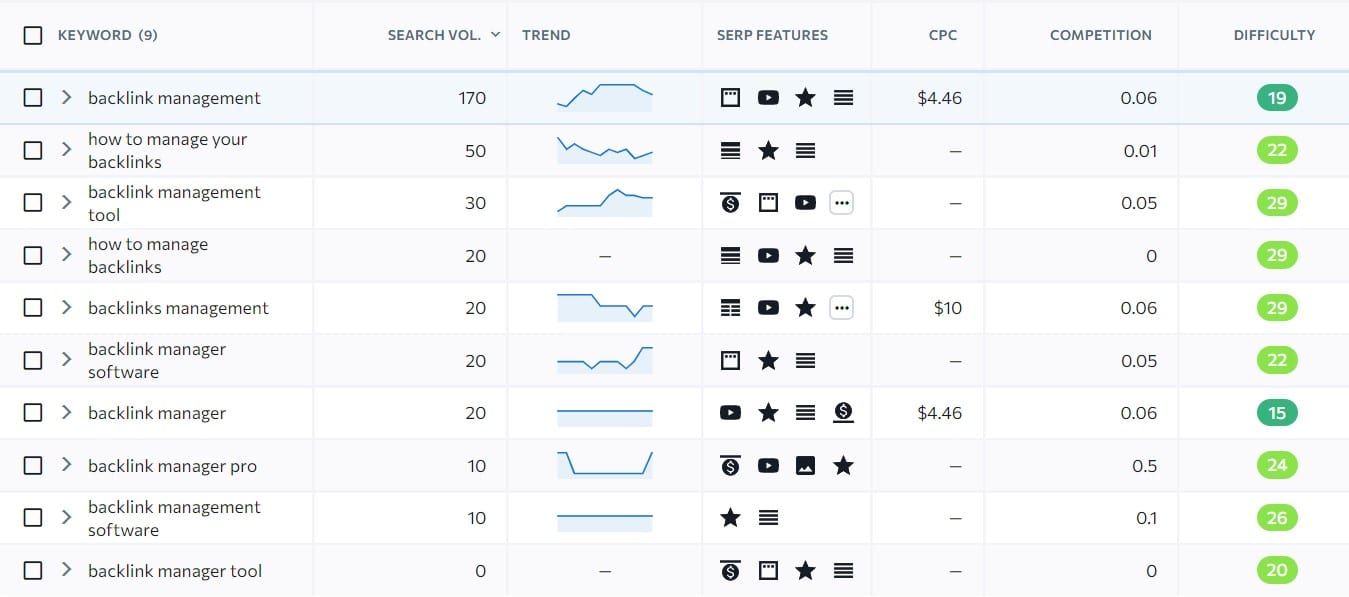
Based on this I can see the keyword “backlink management” is the highest search volume variant.
But now I want to also have a look at the top 3 ranking pages for this keyword and check their ranking keywords, just to double check whether there is any other keyword variant with higher search volume.
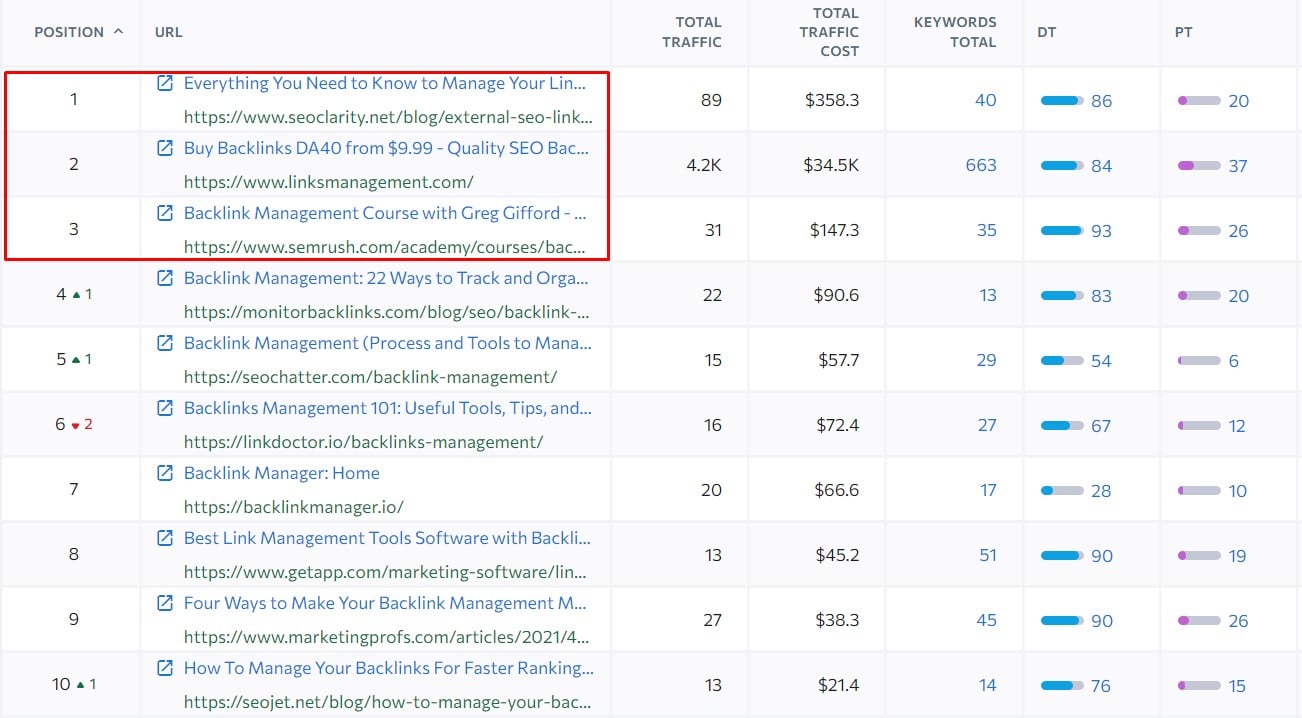
For this example, I only selected the first one and I would skip the second one because it’s their homepage and not a blog post which makes it irrelevant to me.

Here I can see that the keyword “links management” has a higher search volume.
However, I would not personally select this keyword and I would stick with the keyword “backlink management” just because it is a more accurate term, whereas “link management” is a broader term and I would have to talk about backlinks and internal links management as there are two types of links”.
Therefore, for me personally “backlink management” is the primary keyword that I will be targeting.
So, as you can see, sometimes you will need experience and knowledge within the industry to make the right choices for your primary keywords.
Example #2: Keyword “backyard landscaping ideas”
Coming back to the example from step #1 where I have found my keyword “landscaping designs for backyard” is not the primary keyword but the main variant is “backyard landscaping ideas”.
So now, to further analyze it I will check the Keyword Suggestion report to find the highest search volume keyword variant.

Based on this I can see that the keywords “backyard landscapes ideas” and “landscaping ideas for backyard” are having higher search volume.
But, by looking that the search volume trend, I can see that the keyword “backyard landscaping ideas” has better potential. Plus, it has lower keyword difficulty.

Comparing to the higher search volume keywords where the search volume trend is downward and has higher keyword difficulty.

Therefore, I would stick with the keyword “backyard landscaping ideas” as my main primary keyword here.
I could also further analyze the top-ranking pages, but in this case, it is pretty clear that this keyword is the main primary keyword, just because there are so many similar keywords that appeared in the Keyword Suggestion report.
Example #3: Keyword “how to stop a nosebleed”
And with the last example I want to come back to the third example in step #1.
When I look at the Keyword Suggestion report I can see that this keyword is by far the most lucrative in terms of search demand.

However, as you could see a lot of different types of pages appear in the SERPs for this keyword.
Therefore, I will look at the ranking keywords of the top 3 ranking pages and select the one that will have the highest search potential.
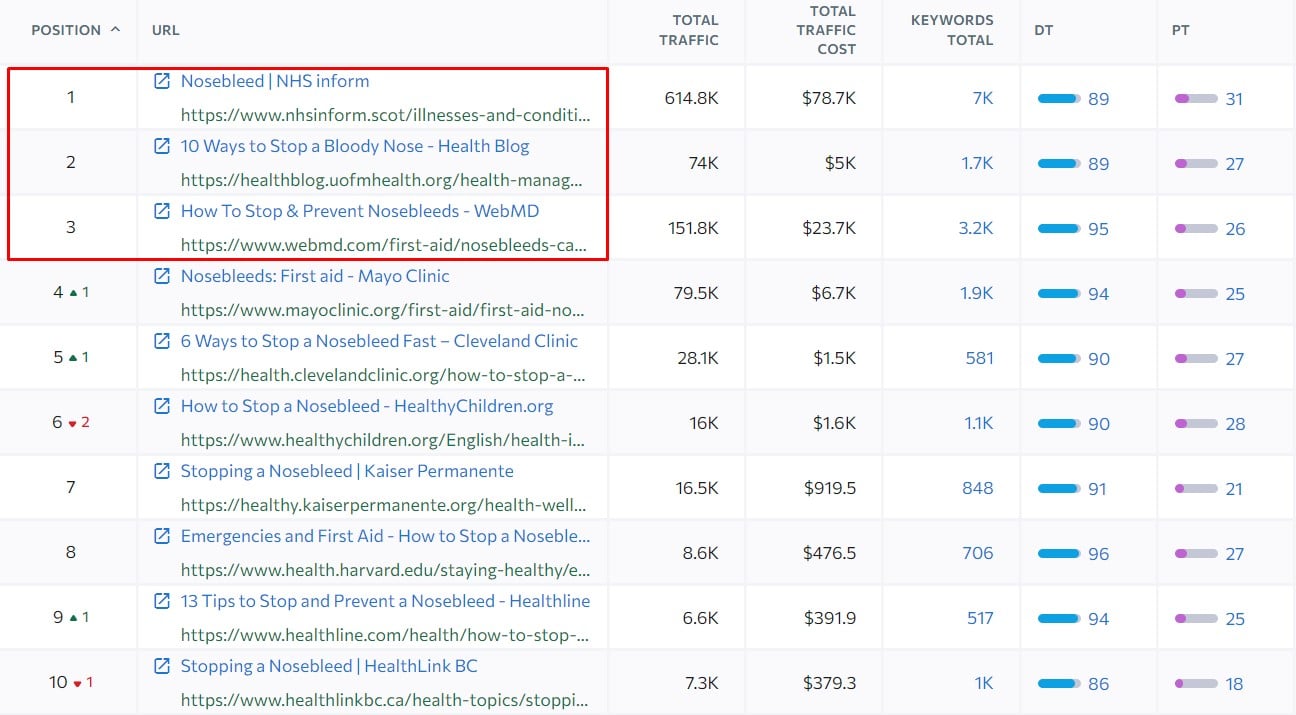
And just by looking at the ranking keywords of the first page, I can see that the best primary keyword variant and the most lucrative is actually only “nosebleed”.
The reason for that is that this keyword is broader and I can target secondary keywords such as “how to stop nosebleed”, “cause of nosebleed” and others within the content which altogether have massive search demand.

And from SERPs analysis, I could already see that just targeting the primary keyword “nosebleed” can rank for these other variants. So, it’s really the best keyword I can target.
On top of that Google already said, that they prefer one big comprehensive piece of content to a lot of small ones, just like in this example.
With that being said, identifying the right primary keyword can be challenging and it comes with experience and knowledge of the industry.
Certainly, it’s not an easy task, but it’s probably the most important together with keyword mapping for your SEO success.
Also, if you are a medical specialist then I recommend you to check out my Local SEO for Doctors guide.
Primary Keywords vs Secondary Keywords

Primary keywords are the main terms that you will want to optimize your web page for and want it to rank for in search engine result pages (SERPs). They are the main keyword variant with the highest organic traffic potential whereas secondary keywords are additional related terms to the one particular primary keyword you are currently optimizing for.
Secondary keywords help to rank for more related terms, increase organic traffic potential and improve the content semantics so Google can better understand what’s the page about and improve the ranking for the page.
Secondary keywords are helping you provide more details to your content and cover it in more depth to ensure you are providing the right information to users searching for the related primary keyword.
Just like I have shown you with the example #3 keyword “how to stop nosebleed”, this keyword is a secondary keyword to the main primary keyword “nosebleed”.
However, what many don’t realize, just because the keyword is secondary for one piece of content, it doesn’t mean the secondary keyword cannot become a primary keyword.
In many cases, secondary keywords can actually become primary keywords in another piece of content.
For example, the primary keyword “on-page seo” can have secondary keywords such as “title tag”, “meta description”, or “keywords” which are closely related to it.
But then I can take these secondary keywords and target them as primary keywords as they are related to my overall niche.

This is how you create extended topic clusters and build a strong semantic SEO foundation for your website. By targeting all related topics within your niche, mainly going deep and covering all the topics related to one part of your niche, you build strong topic relevance for your website.
And this can help you build topical authority which means ranking in the top search results for your related keywords in your niche.

Which overall will improve your website E-E-A-T score.

Primary Keywords Best Practices
1. Target Only 1 Primary Keyword per Page
The first and arguably the most important best practice of them all is to target only one primary keyword per page.
And there are a few reasons why you should only target one primary keyword per page:
- Focusing on one primary keyword allows you to optimize the content of the page specifically for that keyword, instead of confusing the search engines and users by trying to optimize for multiple keywords.
- It can be more difficult for a page to rank well for multiple primary keywords because the content wouldn’t be so relevant to either of those.
- Targeting multiple primary keywords on a single page can also make it more difficult for users and search engines to understand what’s the page about, as the content may be less focused.
For example, if you have a website about “healthy cooking” then you might want to rank for the primary keywords “healthy recipes,” “low-calorie meals,” and “vegetarian dinners.”
However, you shouldn’t try to optimize the page for all three of these primary keywords as it can be difficult, as the page won’t be as relevant to all three keywords.
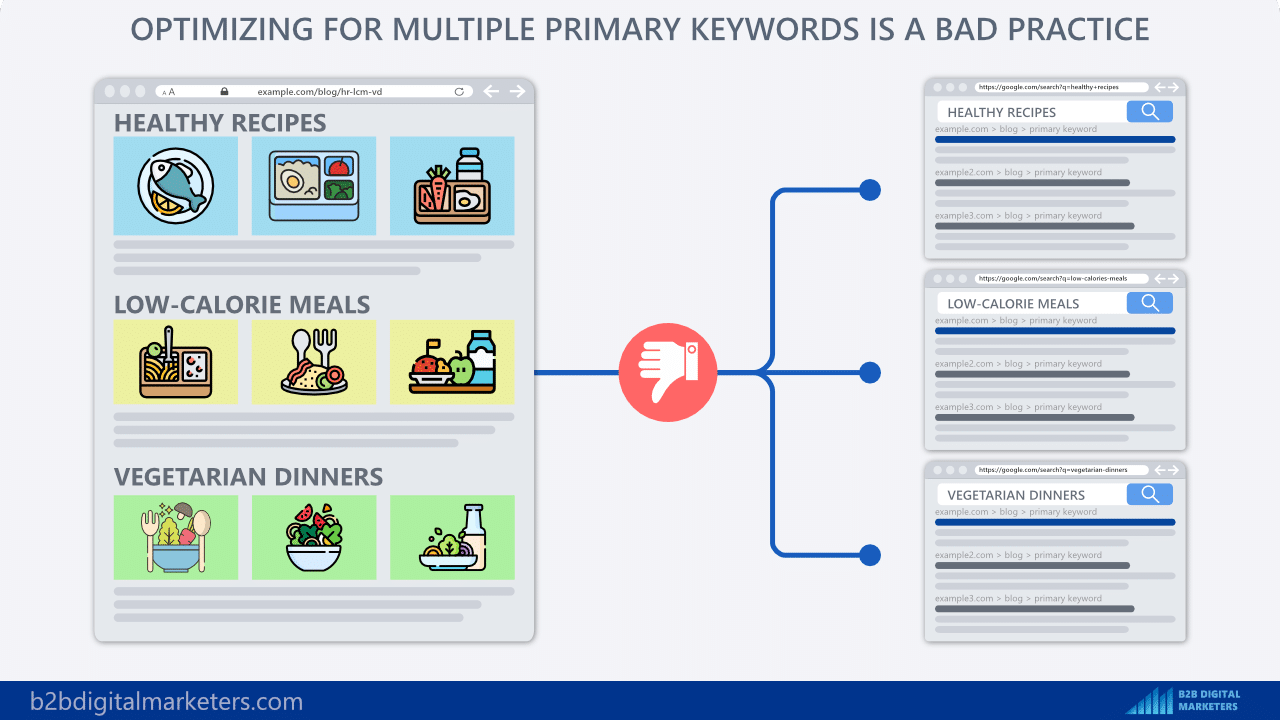
This would not only confuse your users and perhaps annoy them, but also it would be difficult to optimize this page without confusing Google.

Instead, you would create three separate pages for “healthy recipes,” another page for “low-calorie meals,” and a third page for “vegetarian cooking. This would allow you to optimize the content for the primary keyword, meet the search intent and help Google understand what’s your page about.

So, if you were wondering in SEO how many keywords per page, it’s only one primary keyword and several secondary keywords. Also, if you are not sure about your target keywords for each page, I recommend you check out my article on how to find keywords on a website.
2. Have Proper Keyword Placement
Another super important primary keyword best practice is to focus on keyword placement.
As John Mueller said about keyword placement:
“I would recommend that if there’s something that you want to tell us that your page is about, to make that as visible as possible.
So don’t just put that as a one-word mention at the bottom of your article but rather:
- use it in your titles
- use it in your headings
- use it in your subheadings
- use it in captions from images
All of these things, to make it as clear as possible for users and for Google when they go to your page that this page is about this topic.”
Keyword placement is still an essential part of your SEO strategy or B2B SEO strategy and should try to include your primary keywords in certain areas to help Google better understand what’s your content about and make it more relevant for users.
Of course, you want to avoid keyword stuffing and you want to include keywords naturally throughout the content.
With that being said, here is my infographic on keyword placement to help you get started:

Also, if you are using WordPress, then I recommend you check out my guide on where and how to add keywords in WordPress. It will help you to optimize your WordPress content with proper keyword placement.
3. Find Relevant or LSI Keywords to Your Primary Keyword
Another great practice when you are optimizing content for primary keywords is to find relevant or LSI keywords for your primary keyword.
Using relevant LSI keywords helps you to improve the overall clarity and context of the content and add more information, helping both users and search engines because the keywords are semantically related to the primary keyword.
For example, if your primary keyword is “vegan recipes” then some LSI keywords that you can include in your content would be “plant-based”, “vegetarian”, “meatless”, “dairy-free”, and “whole foods”.
By including LSI and relevant keywords you can also improve your ranking for a wider range of related terms, which can increase the organic traffic potential and the visibility of your content in the SERPs. However, keep in mind, that you should always use these terms naturally throughout the content.
With that being said, let me show you a couple of techniques to find relevant LSI keywords:
Technique #1: Check out SERPs for your Primary Keywords
Analyzing SERPs to see what keywords Google finds relevant to your keywords is a great way to start.
For example, let’s say I am targeting the primary keyword “whiskey cocktails”.
So, the best place to start searching for relevant keywords in SERPs is starting at the bottom of the page.

And lastly, you also want to check out the “People also ask (PAA)” box for more ideas and to expand your content.

Technique #2: Check out Your Ranking Competitors
Another way to find related terms is by checking the top-ranking competitors and seeing what they have included. Again, I recommend using keyword research tools for this to remove any personalization.

The goal here is to find all the most commonly mentioned keywords, terms, or topics included within your content as well as those that have not been covered.

As with this, you will include the most popular relevant keywords that perhaps people want to learn about, but also add more information nobody mentioned. Because Google doesn’t want just another “me too content” but is looking for additional value.
As explained by Animalz, Informational Gain is a new concept where Google focuses on pages with at least some unique content compared to others. Basically, the Skyscraper Technique won’t get you on the top anymore.
Technique #3: Check Out the Keyword Suggestion Tool
The next best place where you should look for a related topic and subtopic ideas for your primary keywords as well as to find different keyword variants of your primary keyword is by checking the keyword suggestion tool.
This will help you to get more ideas on how you can write your primary keyword in different ways to avoid keyword stuffing and improve your ranking for these keywords as well, which could help you get more organic traffic and search visibility.
For example, the keywords “rye whiskey cocktails”, “easy whiskey cocktails”, or “classic whiskey cocktails” are all great subcategories I could include.

Technique #4: Use Your Brain
And the last and perhaps most important technique is to use your brain.
If you want to rank at the top, then you need unique content. Therefore, using your own experience, knowledge, and expertise will help you differentiate your content and provide that additional value that others could not.
This will further help you with improving your E-E-A-T score and ranking of your content.
So come up with your own ideas, topics, keywords, and things that you believe should be discussed. It’s important that you don’t skip this step and actually start with it!
Also, I recommend using SEO writing tools such as Surfer SEO, Fraser, or Scalenut that automatically find these terms for you and help you to optimize our content. Check out Surfer SEO alternatives to learn more.
4. Have Internal Links with Primary Keywords as Anchor Text
The next best practice for primary keywords is to optimize your internal links with primary keywords on other of your pages.
Internal links are a crucial part of your on-page SEO as they have a significant impact on your ranking as they can distribute a link juice helping your overall site improve the ranking position and ranking for more related keywords.

And Google also uses the anchor text of internal and external links as an additional signal to get more context about the content.
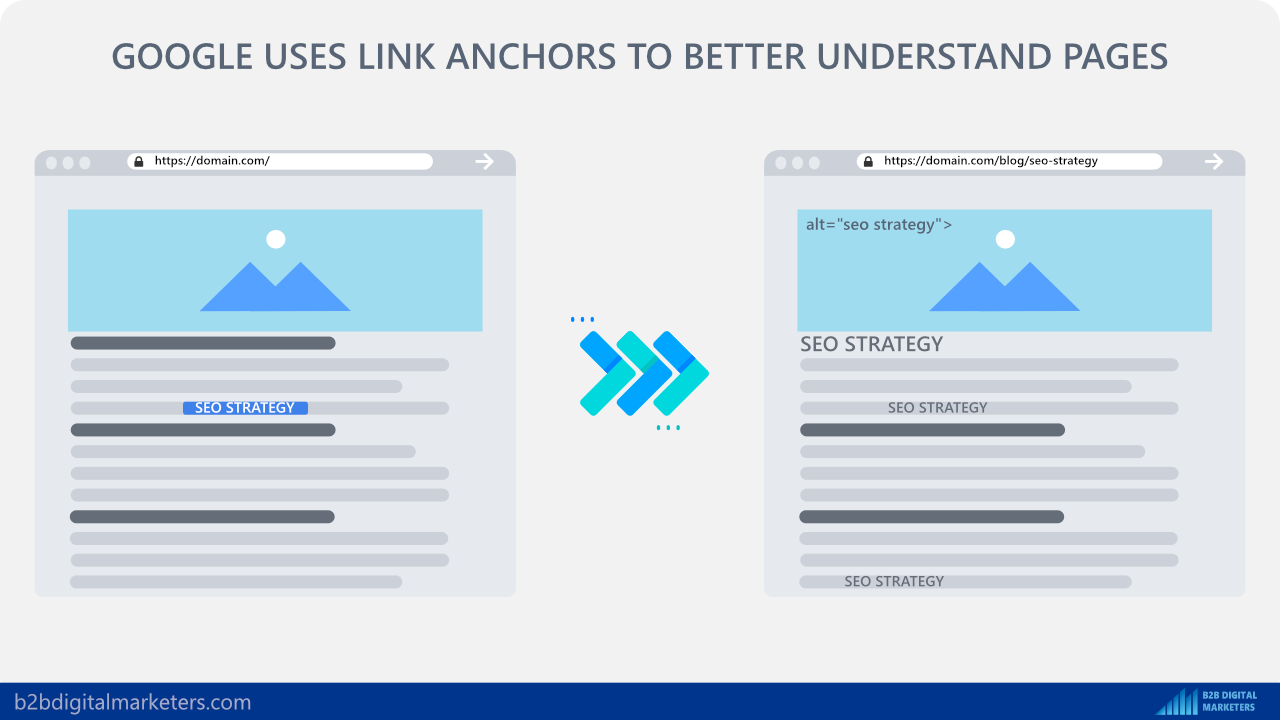
For example, I wrote an article targeting the primary keyword “b2b blogging”. So I have used this Google site operator (site:b2bdigitalmarketers.com “b2b blogging”) to find articles where I have mentioned this primary keyword.
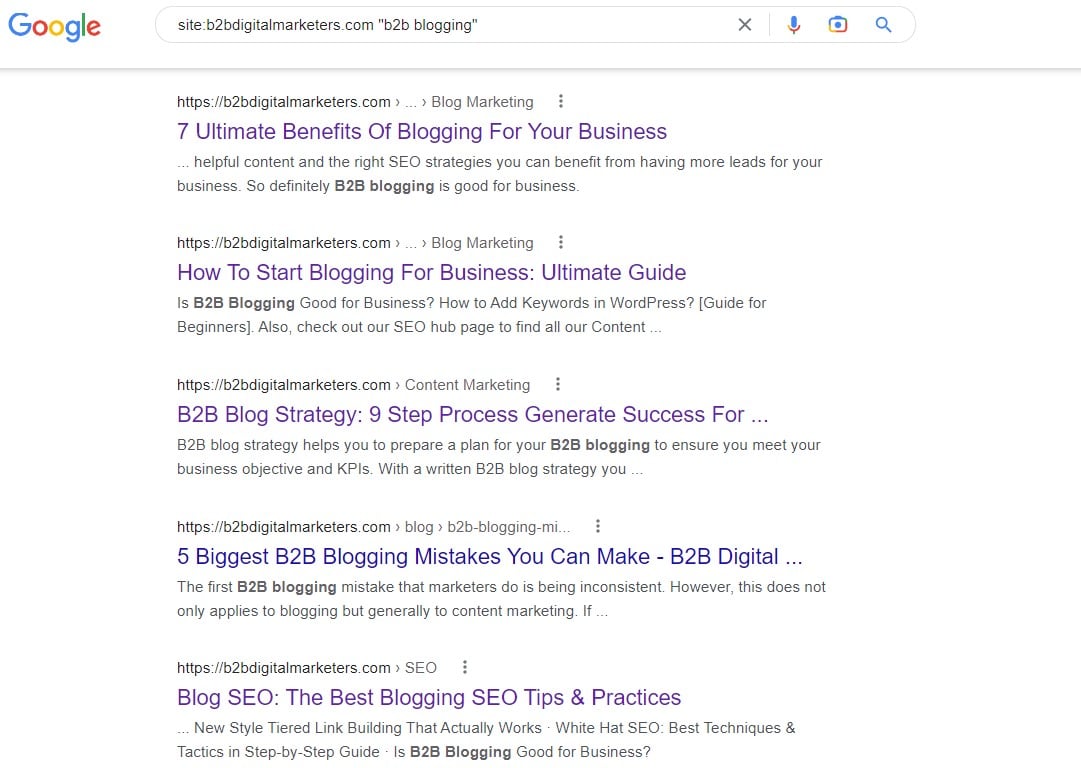
And then included the internal link with the exact anchor text of my primary keyword.
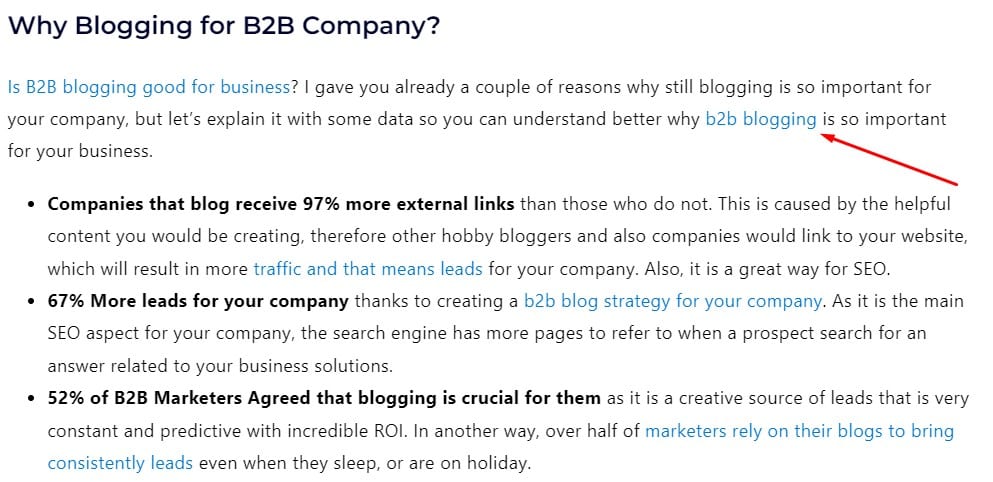
Just like Wikipedia does. Wikipedia loves to use exact-match anchor text for primary keywords all over its website.
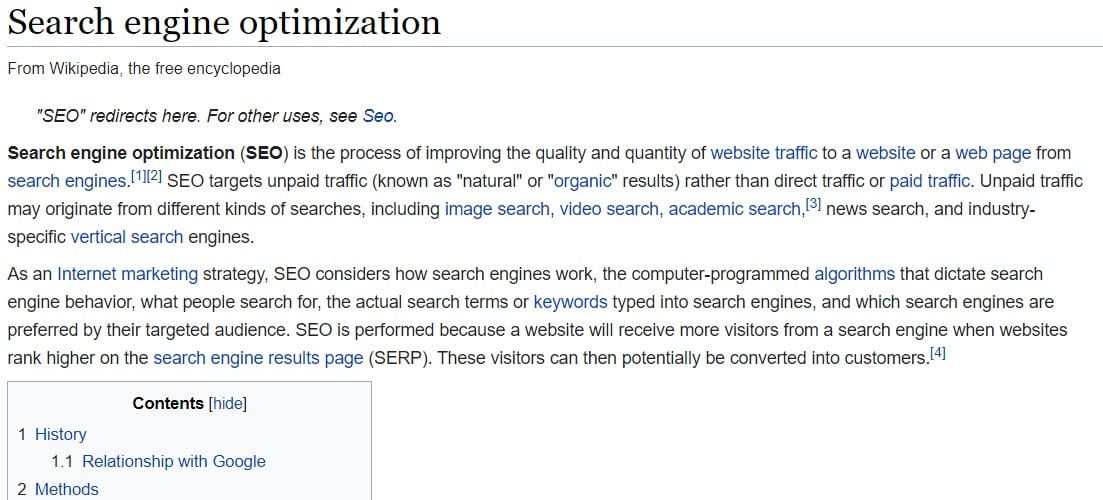
I also use Link Whisper to find any relevant and even primary keywords for my internal links anchor text. However, be careful with it, as it’s not always accurate.

5. Have a Few Backlinks with Primary Keyword as Anchor Text
Similarly, to the fourth practice, you also want to have a few high-quality backlinks with the exact anchor text of your primary keyword.
As said, by John Mueller, anchor text gives Google “quite a bit in understanding context.”

It is important to use specific anchor texts for your primary keywords when creating backlinks. However, it is not advisable to repeat the same anchor text multiple times. Instead, consider using synonyms of your primary keyword as anchor texts.
However, it’s important to note, that this should be only for your contextual backlinks or even better niche-relevant backlinks, and you don’t want to do that just for any backlink.
For example, this page is targeting a primary keyword “organic fertilizer”.

And they have built or got quite a lot of backlinks with the primary keyword as an exact anchor text.

From websites like this one.

However, as I said you should be careful with building too many exact anchor text backlinks. Yes, they can have a significantly positive effect on your ranking, but they are also easy to be spotted by Google algorithm and it can trigger a manual review which could lead to a penalty.
Thus, I recommend you follow my anchor text ratio when you are building backlinks with any link building strategies.

Basically, you want to have less than 10% of target, synonym, and long-tail keywords anchor text and never repeat the same exact anchor text twice.
6. Try to Include Primary Keywords in Subheadings
The next place where you should TRY to include your primary keywords is in the subheadings of your content.
SEO-friendly headlines are an important part of on-page SEO as Google is using headings to better understand the content on the page and it also improves the user experience when you are junking your content into smaller bits of information.
With that, not always you will be able to add primary keywords in your headings again, without making it unnatural. Don’t worry if you can’t – it’s not a must, just try your best.
However, if you can naturally include the primary keyword in a subheading, go for it. For example, in my article on B2B blog strategy, I repeated the primary keyword while explaining the “what,” “why,” and “how’s” for the target keyword.

Just remember to keep the language natural and don’t stress if you can’t fit the keyword into another subheading.
7. Only Include Primary Keywords in Your URL
And the last best practice I have for you is to include your primary keyword in your URL and nothing else.
One of the easiest and most effective SEO best practices is to create SEO-friendly URLs. Unfortunately, many website owners still make the mistake of simply copying the title into the URL.
This is a huge SEO mistake because it prevents the creation of evergreen URLs, particularly if the URL includes the year, date, or a numbered list.
For example, this website exactly copied the title into the URL with a number of strategies. Now, what if they would like to refresh the article and add 2 new strategies?
They would have to redo it, delete this article, and create a new one and that would cause losing all the backlinks and the ranking they got.

Or this website includes the year in it. Again, what are they going to do next year? Redo it? That’s again a waste of effort.

Instead, you want to include only your primary keyword and that’s it.
For example, if you look at any of my articles, you can see that I have done exactly that.

This makes it easy to update my articles every year without deleting them and doing it again and keeping the URL evergreen.
Conclusion to Primary Keywords
In conclusion, primary keywords are a super important part of search engine optimization and for your website and they can help you improve the visibility and reach of your website.
By identifying the main topic of your content and finding specific, relevant primary keywords to optimize for, you can increase the chances that your website will rank high in search results and attract more organic traffic.
By using keyword research tools such as SE Ranking and testing different keywords to see which ones perform the best, you can continually improve your primary keyword strategy and drive more qualified traffic to your website.
Frequently Ask Questions about Primary keywords
There is no rule written in stone for how many times you should use primary keywords in your content. But as I said, you should use them enough to signal to search engines what your content is about, but not so much that it becomes keyword stuffing.
In general, it is recommended to use primary keywords a few times throughout the content, including in the title, headings, images, and throughout the body of the content
However, the exact number of times will depend on the length and nature of your content. Rather than that what’s important is to focus on creating high-quality, relevant, and useful content for your users than on including a specific number of keywords just to meet the threshold.
There are many different ways to find your primary keywords such as doing keyword research, SEO competitor analysis, or simply brainstorming.
For that, I have plenty of articles with techniques to find relevant primary keywords for your niche or industry, check out these articles:
All these articles will help you to find specific primary keywords for your needs, so go through them!
Related Articles:
Also, check out our SEO hub page to find all our SEO resources.
Disclaimer
Some of my links are affiliate links, which means if you purchase something, I might get some small commission as a reward for reference. Of course, I am actively using all these services and products, and I only affiliate products or services I have full trust in their quality!



